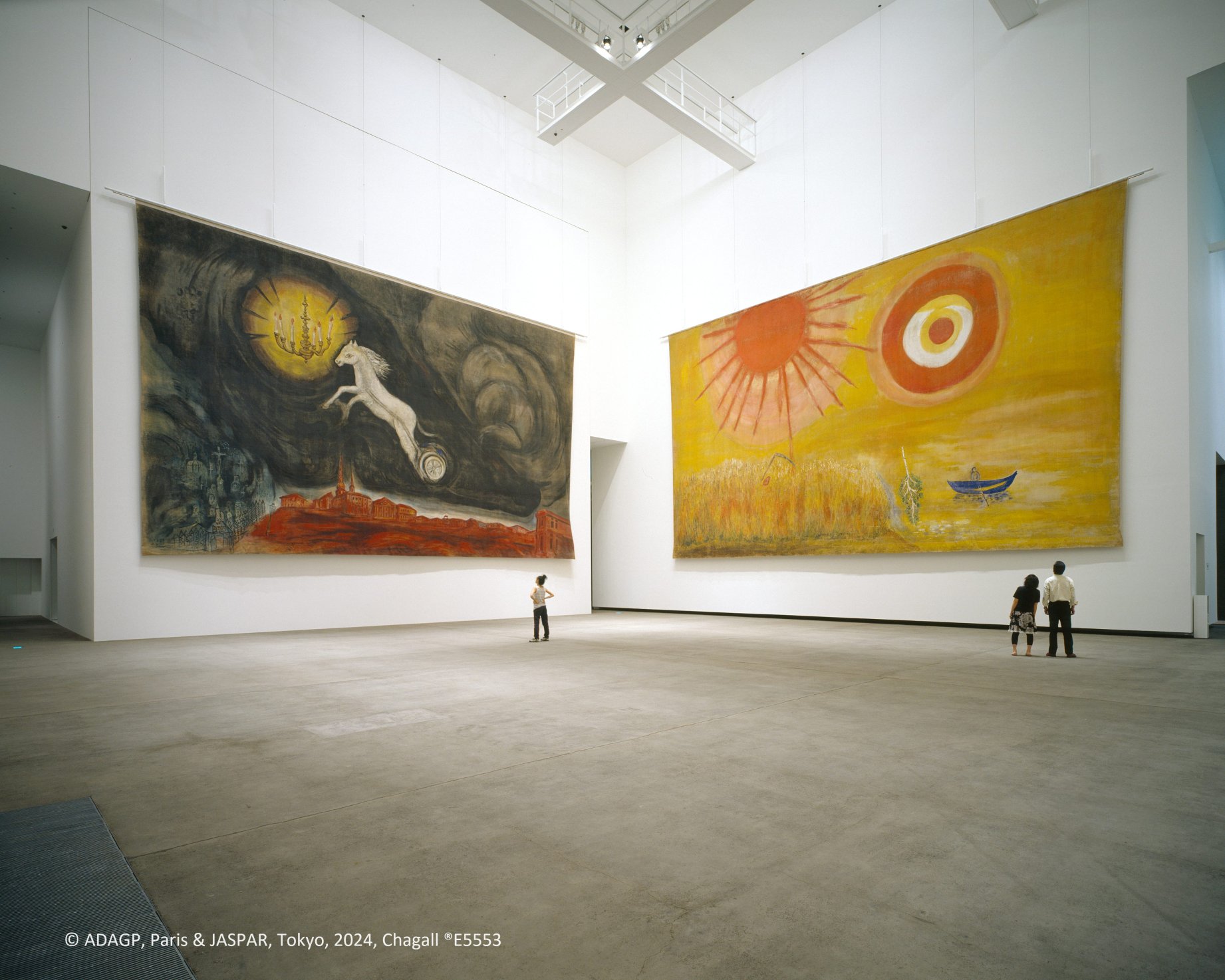
Backdrops for the Ballet "Aleko" by Marc Chagall
At the center of the Aomori Museum of Art stands a four-story space with a height of 19 meters and a width of 21 meters called the Aleko hall. The room exhibits four backdrops for the ballet Aleko painted by the great 20th-century painter Marc Chagall (1887-1985).
In 1994, Aomori Prefecture obtained the backdrops that Chagall painted for the first, second, and fourth acts of Aleko. The remaining third backdrop is in possession of the Philadelphia Museum of Art, but is currently on loan to the Aomori Museum of Art where you can view all four backdrops in one space.
Born in Imperial Russia (present day Belarus) to a Jewish family, Chagall escaped Nazi persecution during World War II and was exiled to the US. The backdrops for Aleko were commissioned by the Ballet Theater (present day American Ballet Theater) during Chagall’s stay in the US. The Aleko masterpieces are perfect displays of Chagall’s talent and live up to his reputation as the “Magician of Color”.
■Marc Chagall (1887-1985)
Born in 1887 to a Jewish family in the town of Viciebsk in Imperial Russia. After studying at an art school in St. Petersburg, Chagall moved to Paris, where he was influenced by the avant-garde art movement. During his early days in Paris he produced some of his masterpieces, such as Self Portrait With Seven Fingers and Birthday. Chagall lived in Russia through World War 1, but in 1923 he restarted his artistic activity in Paris. In 1941 he escaped Nazi persecution and fled to the United States, where he spent the next 7 years. After returning to France, Chagall spent his later years creating a great number of monumental works including tapestries, mosaics, and stained glass windows until his death in 1985.
■The Ballet Aleko
The ballet Aleko is based on Russian novelist Alexander Pushkin’s poem The Gypsies (1827).
Aleko, a young Russian nobleman who has grown tired of civilized society, joins a group of Romani travelers in pursuit of freedom. There he falls in love with the leader’s daughter, Zemphira. Not long after, the free-spirited Zemphira turns her affections to another young Romani man. Learning this, Aleko becomes overwhelmed with rage at Zemphira and her lover and stabs the lovers to death.
The ballet uses an orchestral arrangement of Trio in A Minor composed by the representative Russian composer Pyotr Tchaikovsky. The ballet was choreographed by Léonide Massine, also from Russia.
Intending to pay homage to the great artists of his Russian homeland, Chagall poured extraordinary passion into his work for the ballet. Chagall was entrusted with all aspects of the stage design, not only producing the backdrops but also designing the costumes for many of the dancers. The whole stage was filled with Chagall’s unique creative vision.
The ballet premiered on September 8th, 1942 at the Palacio de Bellas Artes in Mexico City to great success, and would go on to tour around America and Europe.
The four backdrops were used whenever there were performances of Aleko until the late 1960s. When the Ballet Theater let go of the pieces in 1977 they began a new path as pieces of art.
Act 1: Aleko and Zemphira by Moonlight
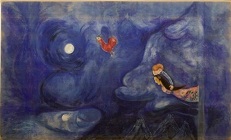
1942 /Tempera on fabric/ 887.8×1472.5cm
The full moon shines brightly in the night sky, reflected in the lake below. On the ground are the tents of the nomadic Romani people. The couple depicted embracing in the sky are the young Russian noble Aleko and the Roma girl Zemphira. Tired of civilized society and in search of freedom, the protagonist Aleko joins a group of Romani travelers and falls in love with the leader’s daughter Zemphira. It is said that the faces of Aleko and Zemphira resemble Chagall and his wife Bella. The blue sky is filled with swirls, bringing to mind the origin of the universe – an apt image for the opening scene of the story.
Aleko and Zemphira appear on stage in time with the first musical passage of Act 1. Zemphira, Aleko, and their Roma companions cross the stage over and over in a passionate dance that expresses the passage of time.
Act 2: The Carnival
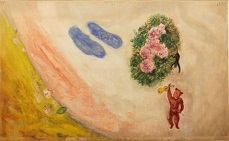
1942 /Tempera on fabric/ 883.5×1452.0cm
Aleko visits various villages across Russia as he travels together with Zemphira and the Romani group. During the carnival, they join together with a circus troupe, singing and dancing while they make the animals perform. Aleko relishes in this free and indulgent lifestyle that is the antithesis to the rigidity of the city. The backdrop features a bear playing the violin while a small monkey’s face can be seen peering through the branches of a tree in full bloom. Chagall drew the village houses on a curve as if trying to constrain the wide plain within the confines of the rectangular canvas. The floating pair of clouds represent two lovers happily enjoying their time together.
On stage, Aleko lays out a mat on the floor on which an acrobat expertly shows off their skills, and a clown draws laughter from the crowd with their humorous antics. With a tambourine in hand, Zemphira gracefully dances and weaves between the performers and the band.
Act 3: A Wheatfield on a Summer's Afternoon
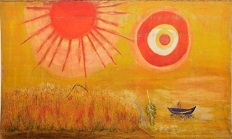
1942 /Tempera on fabric/ 914.4×1524.0cm
Philadelphia Museum of Art: Gift of Leslie and Stanley Westreich, 1986
The backdrop to Act 3 depicts golden wheat fields illuminated by two enormous suns. The young men and women of the farming village perform a sensual dance with this bountiful wheat field in the background. Once the young villagers leave, having enjoyed a brief respite on a summer afternoon, Zemphira appears with a new young Roma lover in tow. The two enjoy the wonders of their newly found love.
Meanwhile, a miserable Aleko chases after Zemphira, pleading for her to return to him, but Zemphira wants nothing to do with him.
The backdrop features the figure of a man rowing a small boat on a pond next to the golden wheat fields. Perhaps the lonely man rowing the boat is Aleko, lamenting the loss of Zemphira’s love.
Act 4: A Fantasy of St Petersburg
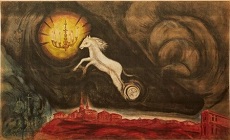
1942 /Tempera on fabric/ 891.5×1472.5cm
In the final act, Aleko goes insane as he burns with jealousy over the loss of Zemphira. The backdrop depicts a white horse-drawn carriage dashing towards a chandelier in the sky above St. Petersburg; the city stained a deep red.
The cemetery, church, and crucifixes drawn in the bottom left corner hint at a tragic ending to this tale.
On stage, Aleko is plagued by nightmares as visions of strange monsters appear and disappear around him. The deranged Aleko comes across Zemphira happily together with her young lover and stabs him to death in a fit of rage. Having lost her lover and reason to live, Zemphira impales herself on Aleko’s knife to join her lover in death.
Even though Aleko chose to join the group of nomadic Romani travelers in pursuit of freedom, he was unable to accept his lover’s uninhibited lifestyle, driving her to her death. Surrounded by a crowd of mourners in the graveyard, Aleko loses consciousness, falls to the ground, and the final curtain falls on the ballet.

